Fluoride Bio-Sorption Efficiency and Antimicrobial Potency of Macadamia Nut Shells
Abstract
:1. Introduction
2. Materials and Methods
2.1. Materials
2.2. Preparation and Characterization of Macadamia Nutshell Powder
2.3. Batch Fluoride Removal Experiments
2.4. Regeneration and Reuse Potential of the Adsorbent
2.5. Antimicrobial Potency
3. Results and Discussion
3.1. Physiochemical Characterization
3.1.1. Elemental Composition
3.1.2. Functional Groups
3.1.3. X-ray Diffraction Analysis
3.1.4. Morphological Analysis
3.1.5. Surface Area Analysis
3.2. Batch Adsorption Experiment
3.2.1. Effect of Contact Time
3.2.2. Effect of pH
3.2.3. The Effect of Adsorbent Dosage
3.2.4. Effect of Initial Concentration
3.2.5. Adsorption Thermodynamics
3.2.6. The Effect of Co-Existing Ions
3.2.7. Adsorbent Reusability
3.3. Antibacterial Activity of MNS
4. Conclusions
Author Contributions
Funding
Institutional Review Board Statement
Informed Consent Statement
Data Availability Statement
Acknowledgments
Conflicts of Interest
References
- Gao, X.; Luo, W.; Luo, X.; Li, C.; Zhang, X.; Wang, Y. Indigenous microbes induced fluoride release from aquifer sediments. Environ. Pollut. 2019, 252, 580–590. [Google Scholar] [CrossRef] [PubMed]
- Masindi, V.; Foteinis, S. Groundwater contamination in sub-Saharan Africa: Implications for groundwater protection in developing countries. Clean. Eng. Technol. 2021, 2, 100038. [Google Scholar] [CrossRef]
- Chaudhary, K.; Saraswat, P.K.; Khan, S. Improvement in fluoride remediation technology using GIS based mapping of fluoride contaminated groundwater and microbe assisted phytoremediation. Ecotoxicol. Environ. Saf. 2019, 168, 164–176. [Google Scholar] [CrossRef]
- World Health Organization (WHO). Guidelines for Drinking-Water Quality: Fourth Edition Incorporating the First Addendum; Licence: CC BY-NC-SA 3.0 IGO; WHO: Geneva, Switzerland, 2017. [Google Scholar]
- Garg, R.; Garg, R.; Thakur, A.; Arif, S.M. Water Remediation Using Biosorbent Obtained from Agricultural and Fruit Waste. Mater. Today Proc. 2021, 46, 6669–6672. [Google Scholar] [CrossRef]
- Mukherjee, S.; Halder, G. A review on the sorptive elimination of fluoride from contaminated wastewater. J. Environ. Chem. Eng. 2018, 6, 1257–1270. [Google Scholar] [CrossRef]
- Mudzielwana, R.; Gitari, M.W.; Akinyemi, S.A.; Msagati, T.A.M. Synthesis and physicochemical characterization of MnO2 coated Na-bentonite for groundwater defluoridation: Adsorption modelling and mechanistic aspect. Appl. Surf. Sci. 2017, 422, 745–753. [Google Scholar] [CrossRef]
- Thakur, V.; Sharma, E.; Guleria, A.; Sangar, S.; Singh, K. Modification and management of lignocellulosic waste as an ecofriendly biosorbent for the application of heavy metal ions sorption. Mater. Today Proc. 2020, 32, 608–619. [Google Scholar] [CrossRef]
- Izuagie, A.A.; Gitari, W.M.; Gumbo, J.R. Defluoridation of groundwater using diatomaceous earth: Optimization of adsorption conditions, kinetics and leached metals risk assessment. Desalination Water Treat. 2015, 57, 1–13. [Google Scholar] [CrossRef]
- Liang, W.; Couperthwaite, S.J.; Kaur, G.; Yan, C.; Johnstone, D.W.; Millar, G.J. Effect of strong acids on red mud structural and fluoride adsorption properties. J. Colloid Interface Sci. 2014, 423, 158–165. [Google Scholar] [CrossRef] [Green Version]
- Chen, C.-L.; Park, S.-W.; Su, J.F.; Yu, Y.-H.; Heo, J.-E.; Kim, K.-D.; Huang, C. The adsorption characteristics of fluoride on commercial activated carbon treated with quaternary ammonium salts (Quats). Sci. Total Environ. 2019, 693, 133605. [Google Scholar] [CrossRef]
- Ye, C.; Yan, B.; Ji, X.; Liao, B.; Gong, R.; Pei, X.; Liu, G. Adsorption of fluoride from aqueous solution by fly ash cenospheres modified with paper mill lime mud: Experimental and modeling. Ecotoxicol. Environ. Saf. 2019, 180, 366–373. [Google Scholar] [CrossRef] [PubMed]
- Saini, J.K.; Saini, R.; Tewari, L. Lignocellulosic agriculture wastes as biomass feedstocks for second-generation bioethanol production: Concepts and recent developments. 3 Biotech. 2015, 5, 337–353. [Google Scholar] [CrossRef] [Green Version]
- Anastopoulos, I.; Pashalidis, I.; Hosseini-Bandegharaei, A.; Giannakoudakis, D.A.; Robalds, A.; Usman, M.; Escudero, L.B.; Zhou, Y.; Colmenares, J.C.; Núñez-Delgado, A.; et al. Agricultural biomass/waste as adsorbents for toxic metal decontamination of aqueous solutions. J. Mol. Liq. 2019, 295, 111684. [Google Scholar] [CrossRef]
- Antal, M.J.; Gronli, M.G. The Art, Science, and Technology of Charcoal Production. Ind. Eng. Chem. Res. 2003, 42, 1619–1640. [Google Scholar] [CrossRef]
- Macadamia South Africa (SAMC), An Overview of the South African Macadamia Industry. 2019. Available online: https://www.samac.org.za (accessed on 5 January 2021).
- Pakade, V.E.; Ntuli, T.; Ofomaja, A.E. Biosorption of hexavalent chromium from aqueous solutions by Macadamia nutshell powder. Appl. Water Sci. 2016, 7, 3015–3030. [Google Scholar] [CrossRef] [Green Version]
- Gitari, W.; Ngulube, T.; Masindi, V.; Gumbo, J.R. Defluoridation of groundwater using Fe3+-modified bentonite clay: Optimization of adsorption conditions. Desalination Water Treat. 2013, 53, 1578–1590. [Google Scholar] [CrossRef]
- Altun, T.; Pehlivan, E. Removal of Cr (VI) from aqueous solutions by modified walnut shells. Food Chem. 2012, 132, 693–700. [Google Scholar] [CrossRef]
- Zhao, X.; Chen, J.; Chen, F.; Wang, X.; Zu, Q.; Ao, Q. Surface characterization of corn stalk superfine power studied by FTIR and XRD. Colloids Surf. B Biointerface 2013, 104, 207–212. [Google Scholar] [CrossRef]
- Yang, H.; Dong, Z.; Liu, B.; Chen, Y.; Gong, M.; Li, S.; Chen, H. A new insight of lignin pyrolysis mechanism based on functional group evolutions of solid char. Fuel 2021, 288, 119719. [Google Scholar] [CrossRef]
- Albadarin, A.; Al-Muhtaseb, A.; Al-Laqtah, N.A.; Walker, G.; Allen, S.J.; Ahmad, M. Biosorption of toxic chromium from aqueous phase by lignin: Mechanism, effect of other metal ions and salts. Chem. Eng. J. 2011, 169, 20–30. [Google Scholar] [CrossRef]
- Gupta, S.S.; Bhattacharyya, K.G. Kinetics of adsorption of metal ions on inorganic materials: A review. Adv. Colloid Interface Sci. 2011, 162, 39–58. [Google Scholar] [CrossRef] [PubMed]
- Simonin, J.P. On the comparison of pseudo-first order and pseudo-second order rate laws in the modeling of adsorption kinetics. Chem. Eng. J. 2016, 300, 254–263. [Google Scholar] [CrossRef] [Green Version]
- Febrianto, J.; Kosasih, A.N.; Sunarso, J.; Ju, Y.-H.; Indraswati, N.; Ismadji, S. Equilibrium and kinetic studies in adsorption of heavy metals using biosorbent: A summary of recent studies. J. Hazard. Mater. 2009, 162, 616–645. [Google Scholar] [CrossRef]
- Ayinde, W.; Gitari, W.; Munkombwe, M.; Amidou, S. Green synthesis of Ag/MgO nanoparticle modified nanohydroxyapatite and its potential for defluoridation and pathogen removal in groundwater. Phys. Chem. Earth Parts A/B/C 2018, 107, 25–37. [Google Scholar] [CrossRef]
- Mudzielwana, R.; Gitari, W.M.; Ndungu, P. Evaluation of the adsorptive properties of locally available alumino-silicate clay in As(III) and As(V) remediation from groundwater. Phys. Chem. Earth Parts A/B/C 2018, 112, 28–35. [Google Scholar] [CrossRef]
- Weber, W.J., Jr.; Morris, J.C. Equilibria and capacities for adsorption on carbon. J. Sanit. Eng. Div. 1964, 90, 79–108. [Google Scholar] [CrossRef]
- Bullen, J.C.; Saleesongsom, S.; Gallagher, K.; Weiss, D.J. A Revised Pseudo-Second-Order Kinetic Model for Adsorption, Sensitive to Changes in Adsorbate and Adsorbent Concentrations. Langmuir 2021, 37, 3189–3201. [Google Scholar] [CrossRef]
- Tran, H.N.; You, S.-J.; Chao, H.-P. Thermodynamic parameters of cadmium adsorption onto orange peel calculated from various methods: A comparison study. J. Environ. Chem. Eng. 2016, 4, 2671–2682. [Google Scholar] [CrossRef]
- Foo, K.Y.; Hameed, B.H. Insights into the modeling of adsorption isotherm systems. Chem. Eng. J. 2010, 156, 2–10. [Google Scholar] [CrossRef]
- Tran, H.N.; You, S.-J.; Hosseini-Bandegharaei, A.; Chao, H.-P. Mistakes and inconsistencies regarding adsorption of contaminants from aqueous solutions: A critical review. Water Res. 2017, 120, 88–116. [Google Scholar] [CrossRef] [PubMed]
- Singh, K.; Lataye, D.H.; Wasewar, K.L. Removal of Fluoride from Aqueous Solution by Using Low-Cost Sugarcane Bagasse: Kinetic Study and Equilibrium Isotherm Analyses. J. Hazard. Toxic Radioact. Waste 2016, 20, 04015024. [Google Scholar] [CrossRef]
- George, A.M.; Tembhurkar, A.R. Analysis of equilibrium, kinetic, and thermodynamic parameters for biosorption of fluoride from water onto coconut (Cocos nucifera Linn.) root developed adsorbent. Chin. J. Chem. Eng. 2019, 27, 92–99. [Google Scholar] [CrossRef]
- Yadav, A.K.; Abbassi, R.; Gupta, A.; Dadashzadeh, M. Removal of fluoride from aqueous solution and groundwater by wheat straw, sawdust and activated bagasse carbon of sugarcane. Ecol. Eng. 2013, 52, 211–218. [Google Scholar] [CrossRef]
- Srinivasulu, D. Senna auriculata L. flower petal biomass: An alternative green biosorbent for the removal of fluoride from aqueous solutions. Acta Ecol. Sin. 2021, in press. [Google Scholar] [CrossRef]
- Zhou, N.; Guo, X.; Ye, C.; Yan, L.; Gu, W.; Wu, X.; Zhou, Q.; Yang, Y.; Wang, X.; Cheng, Q. Enhanced fluoride removal from drinking water in wide pH range using La/Fe/Al oxides loaded rice straw biochar. Water Supply 2021. [Google Scholar] [CrossRef]
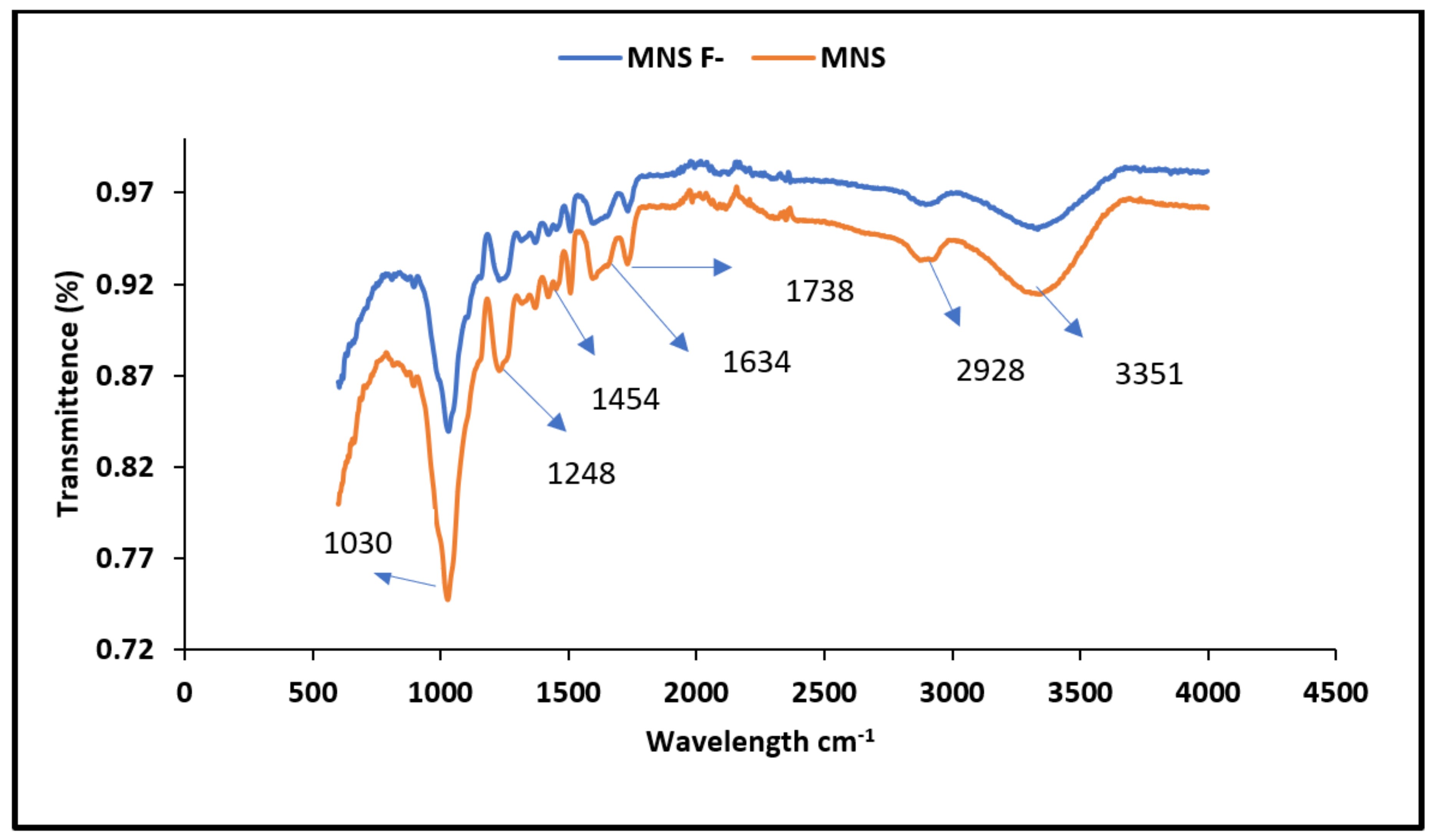
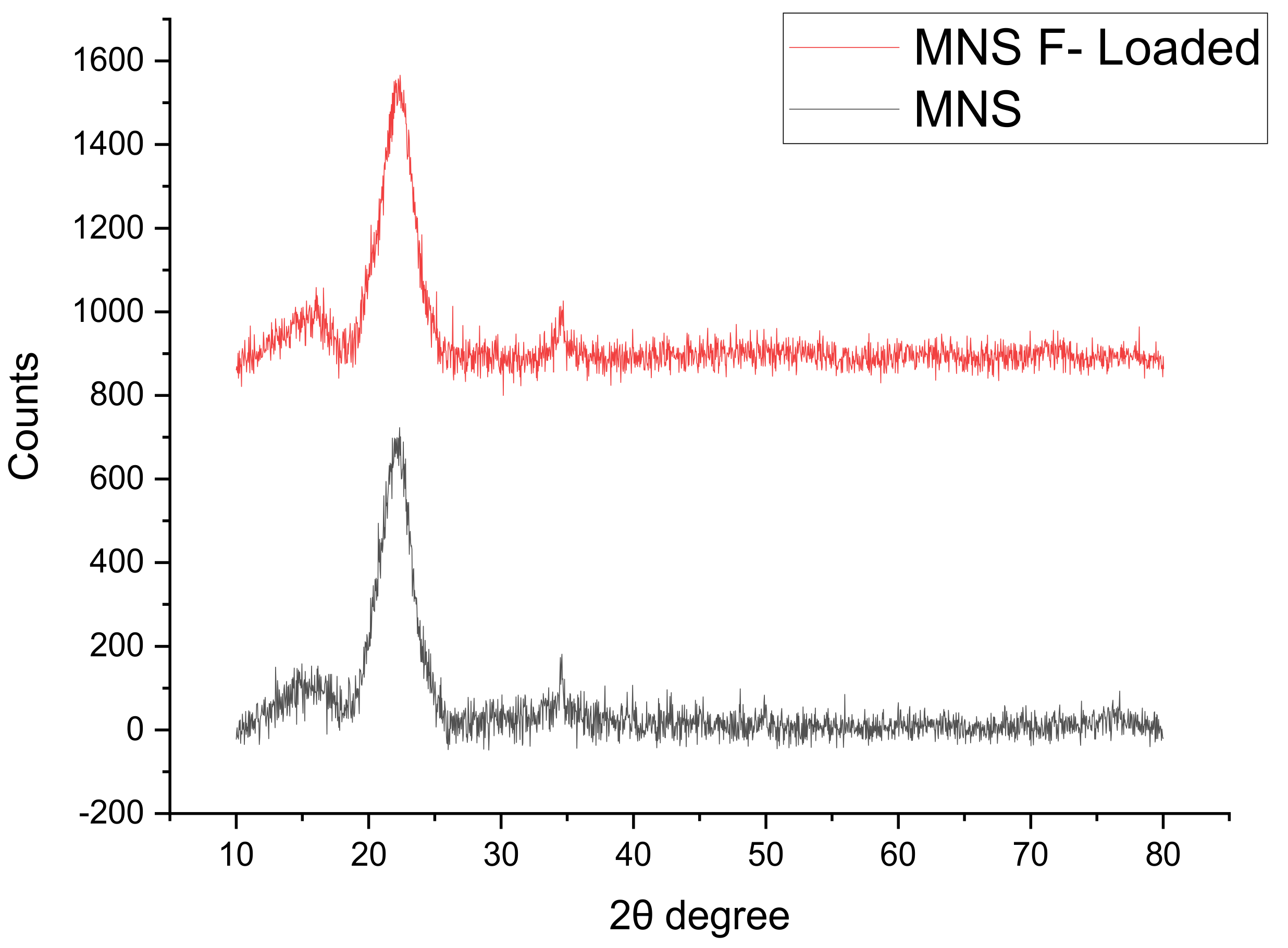
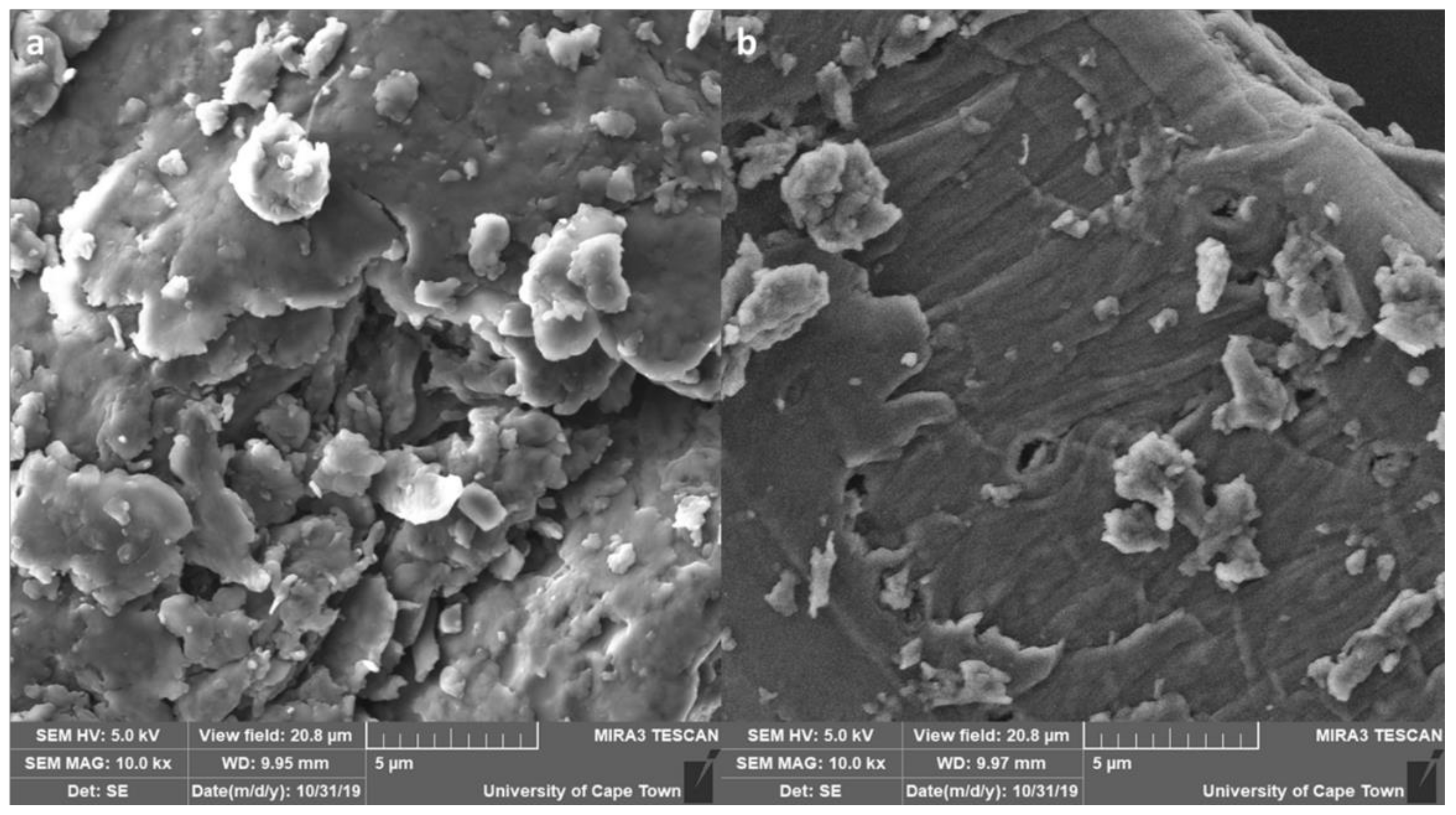
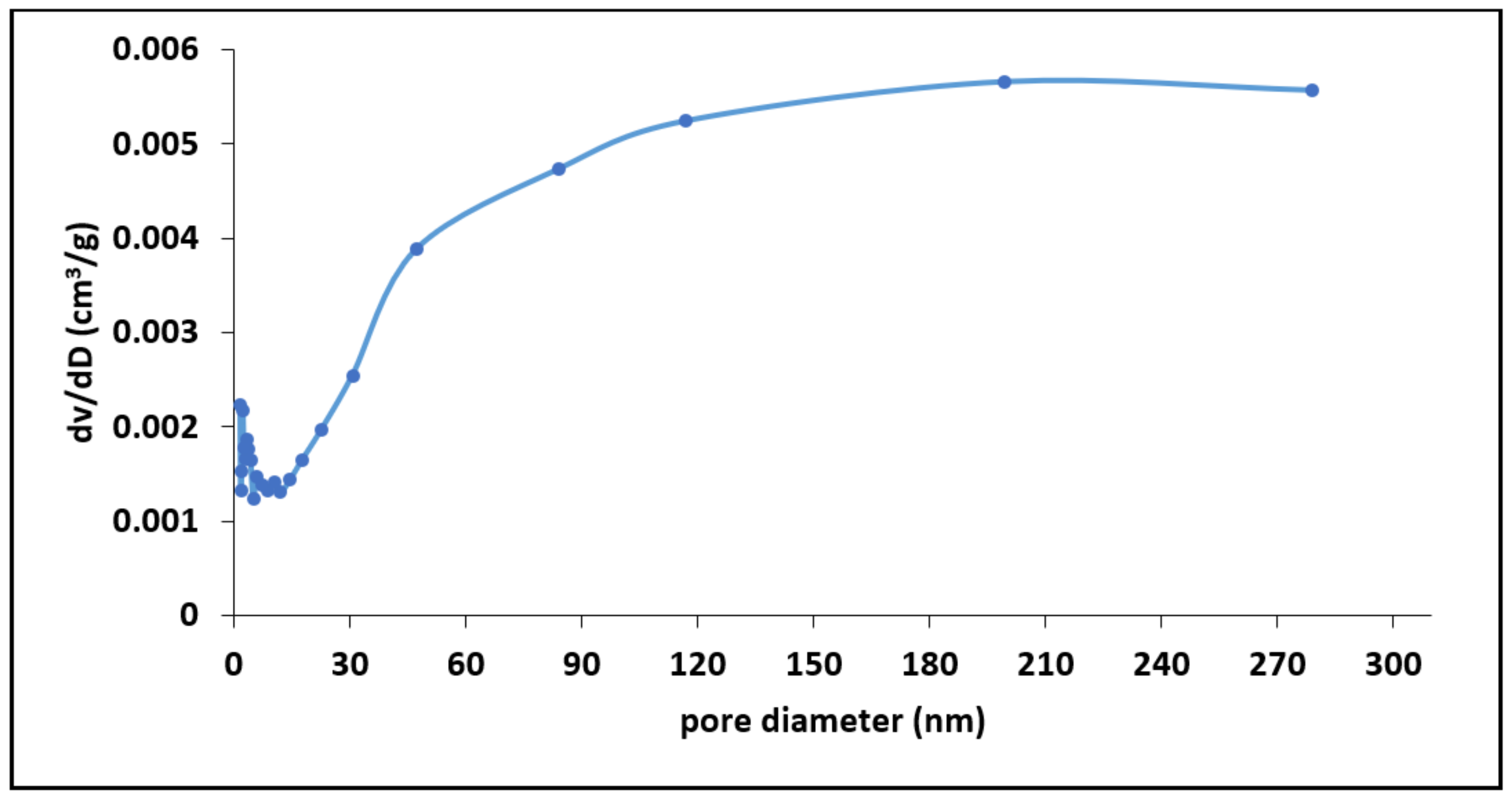
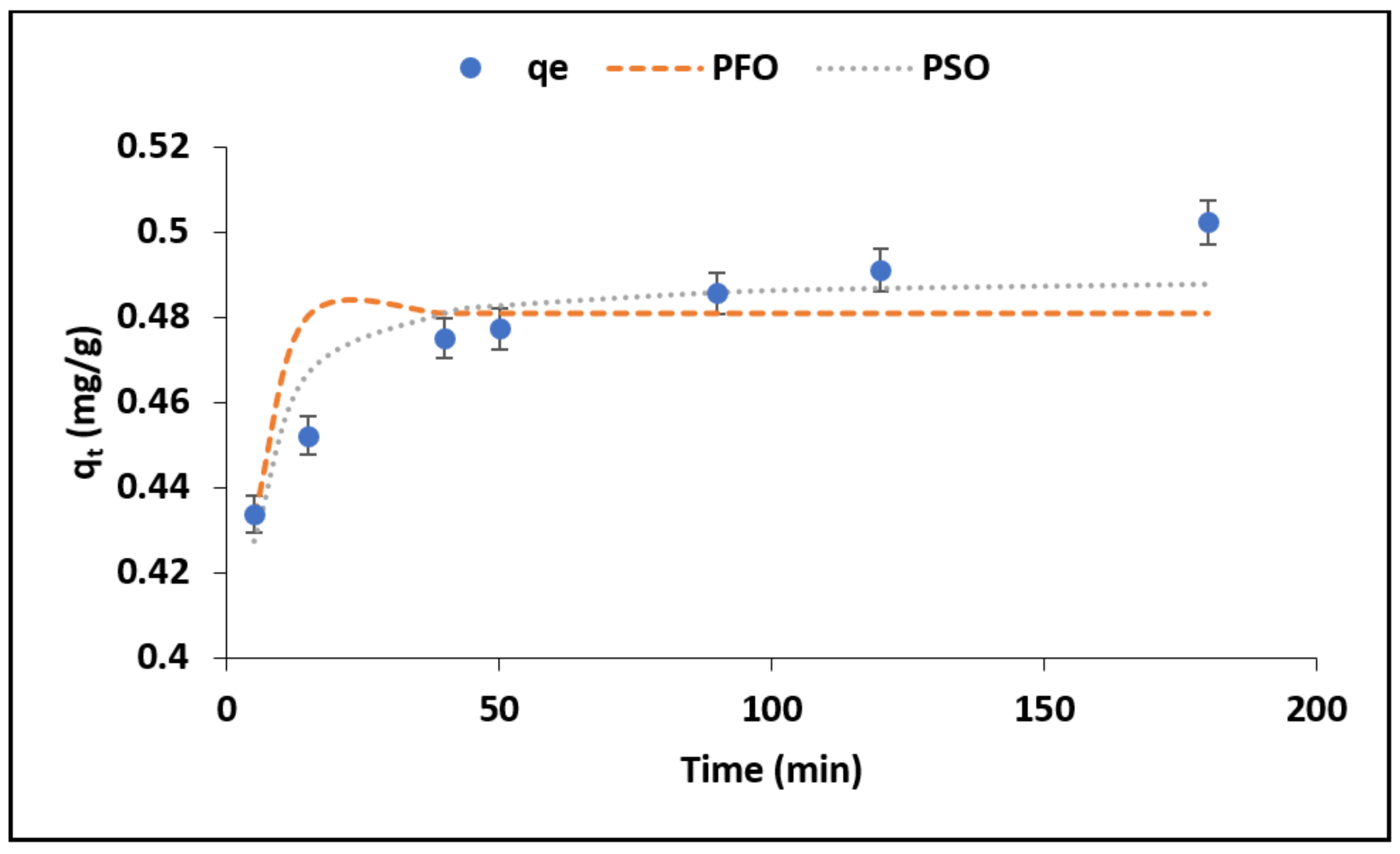
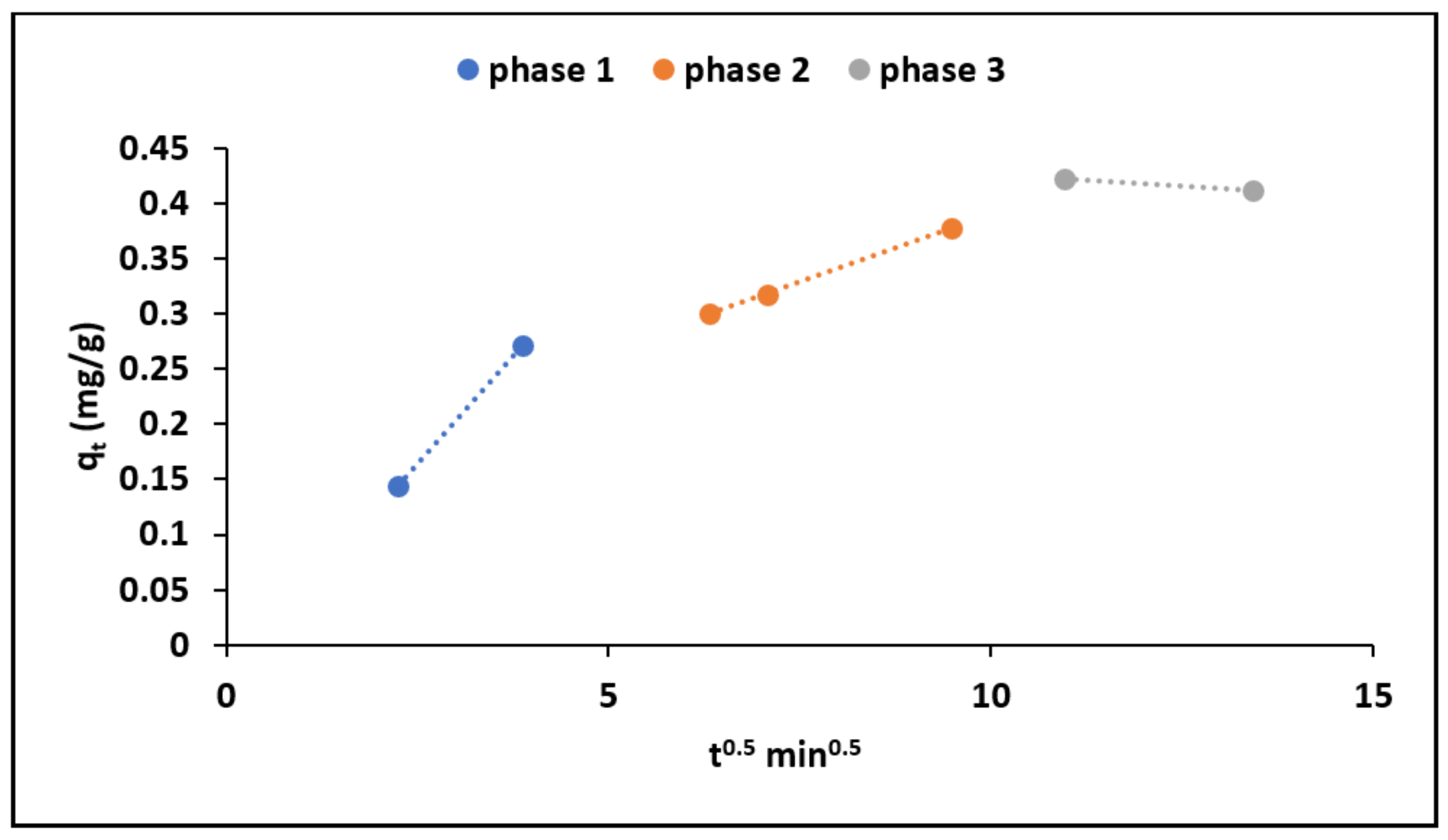

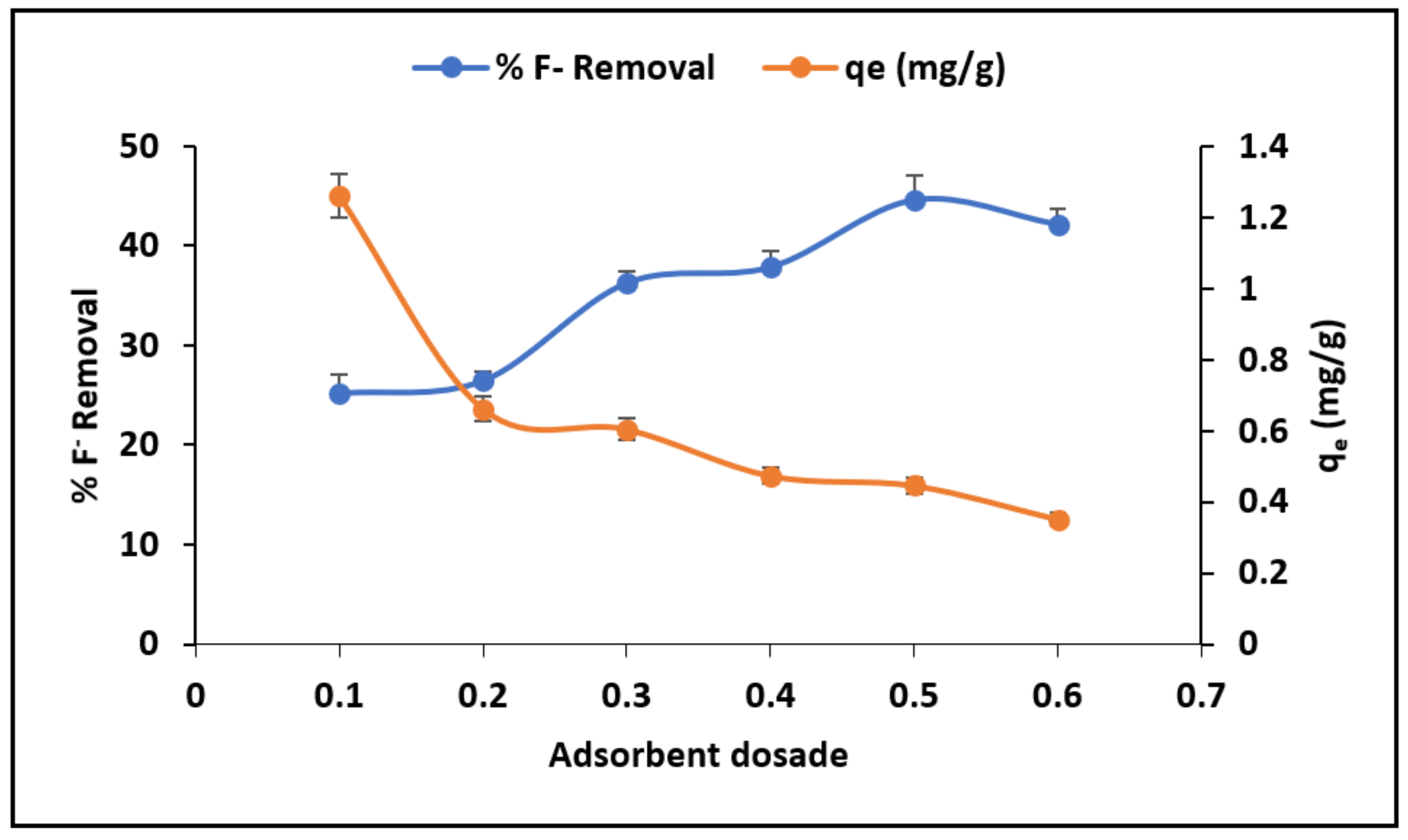
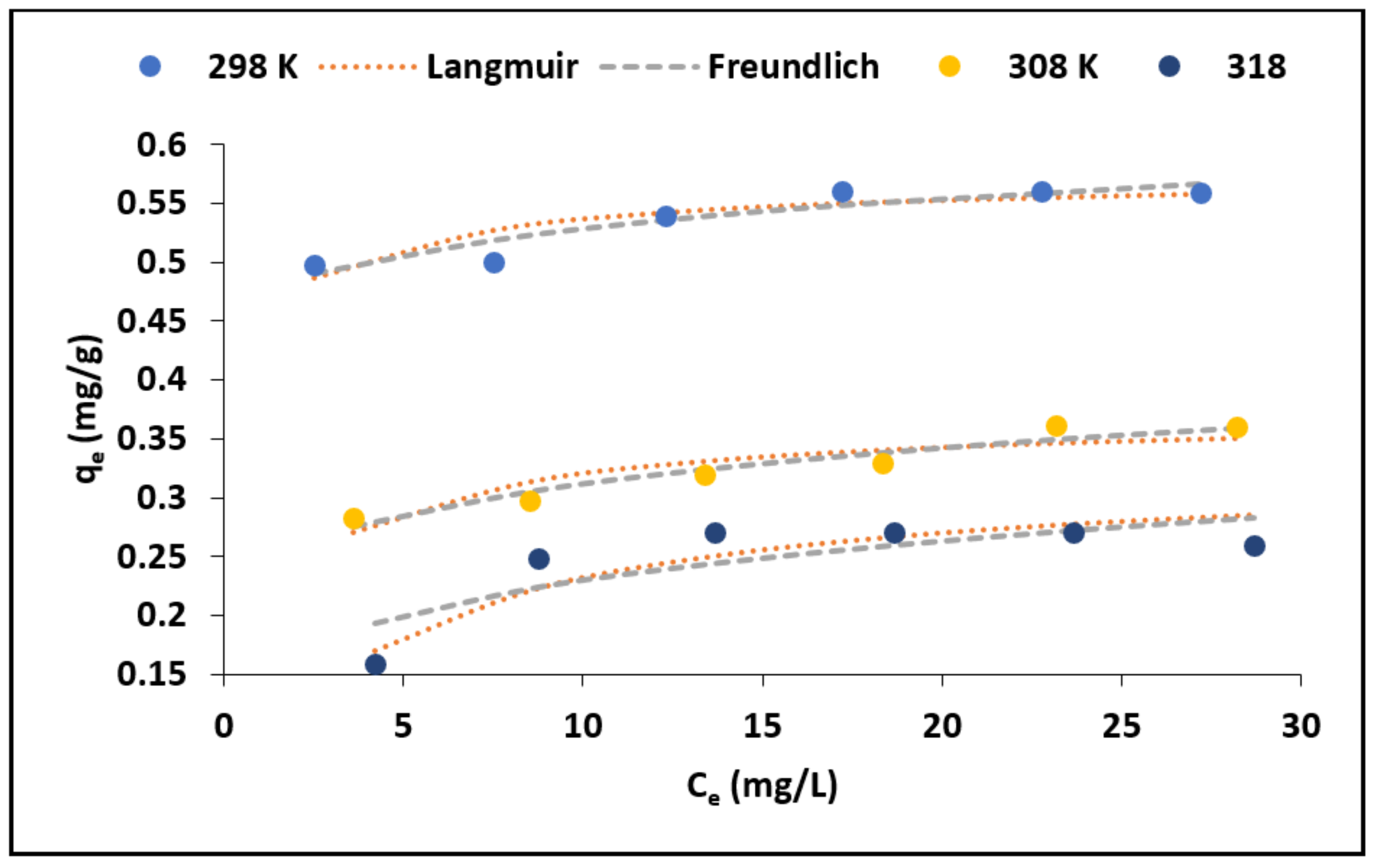
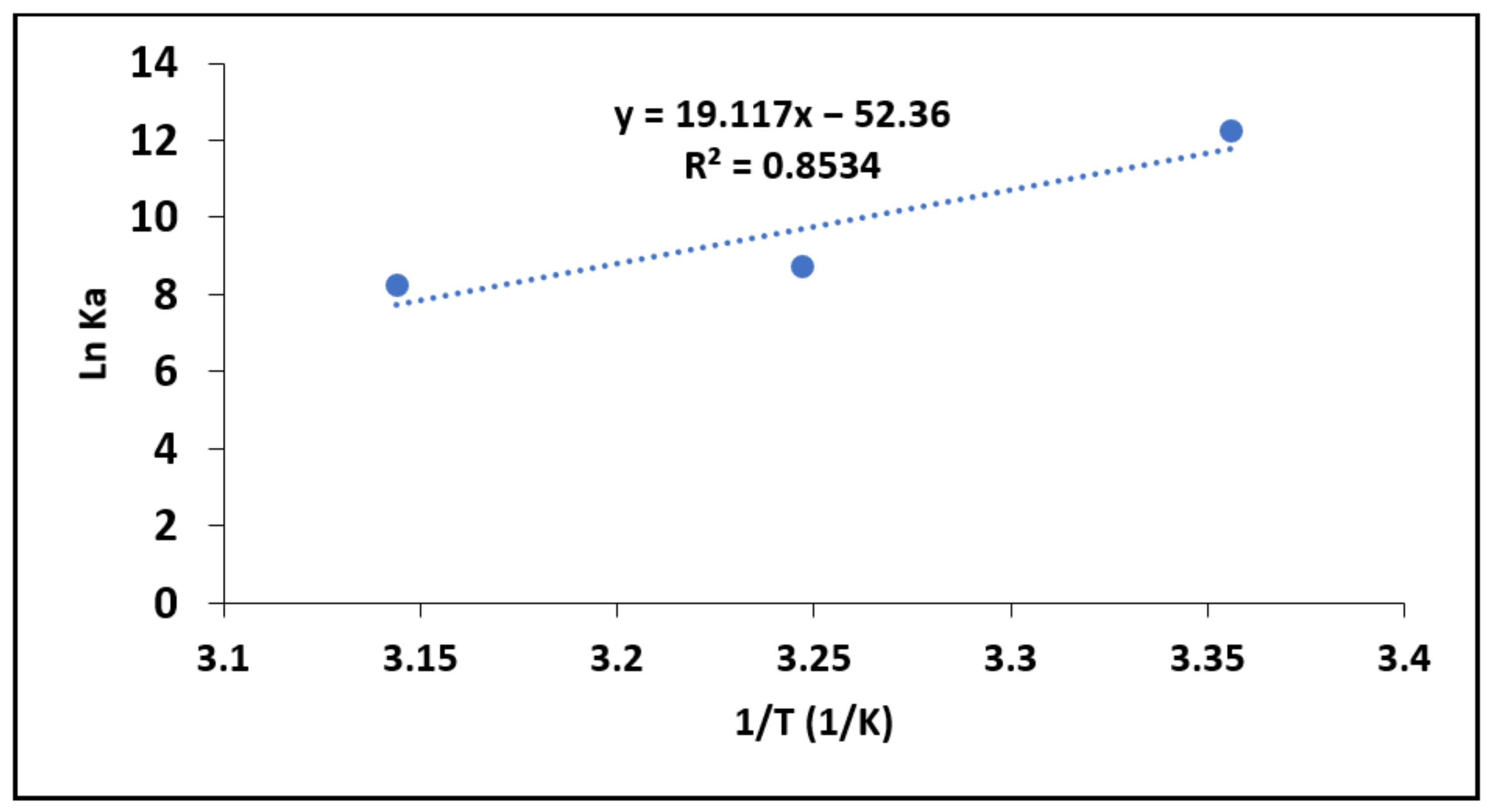
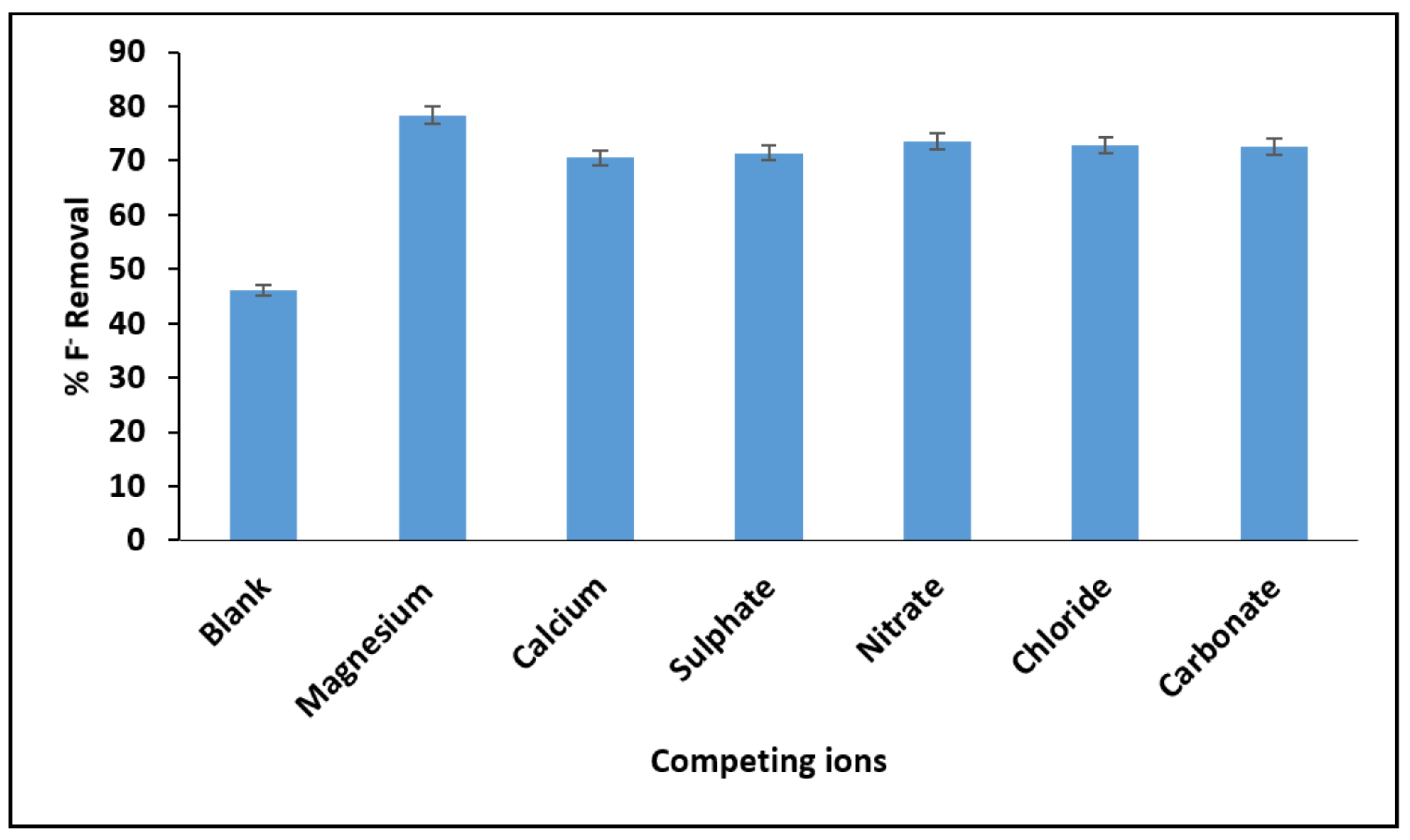
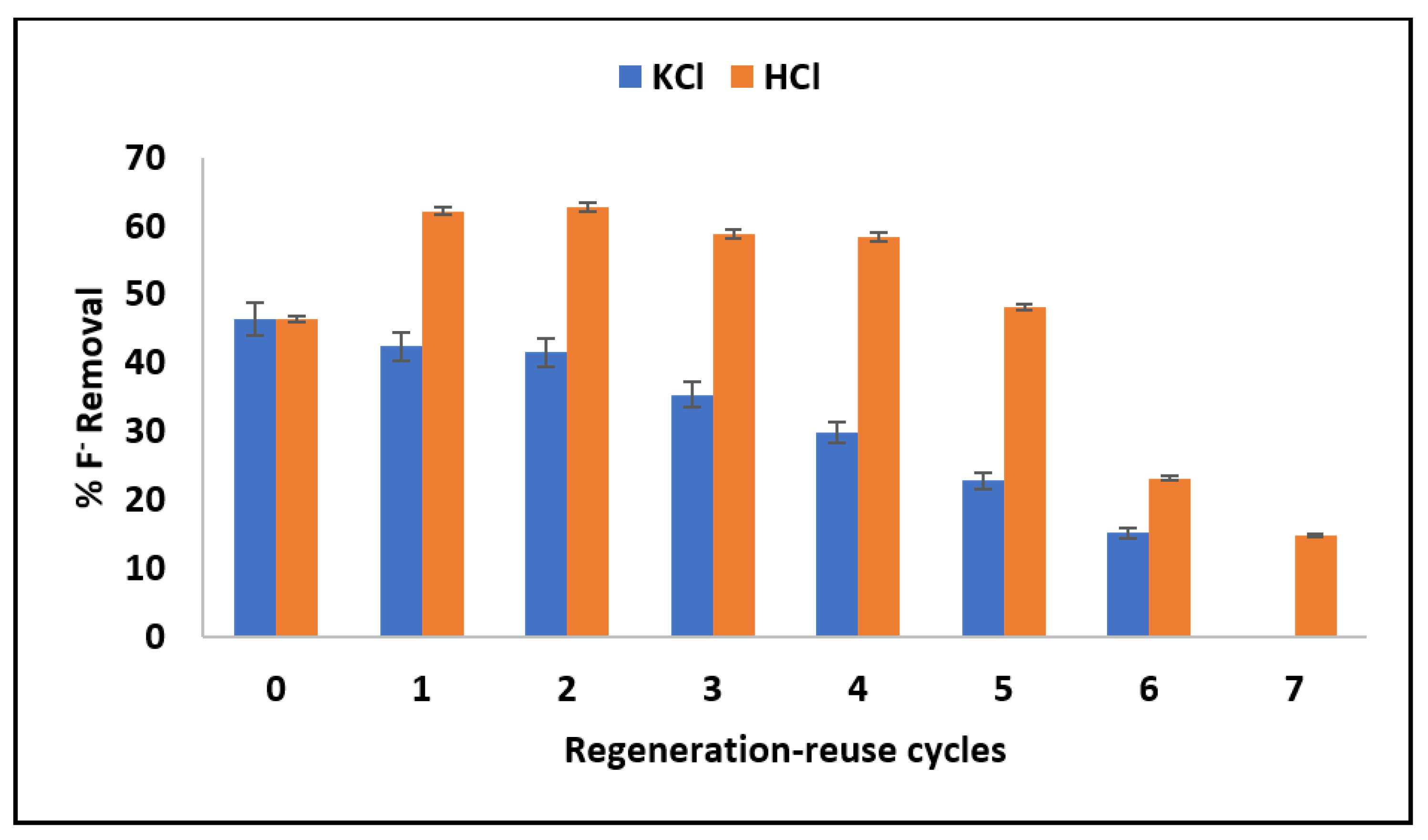
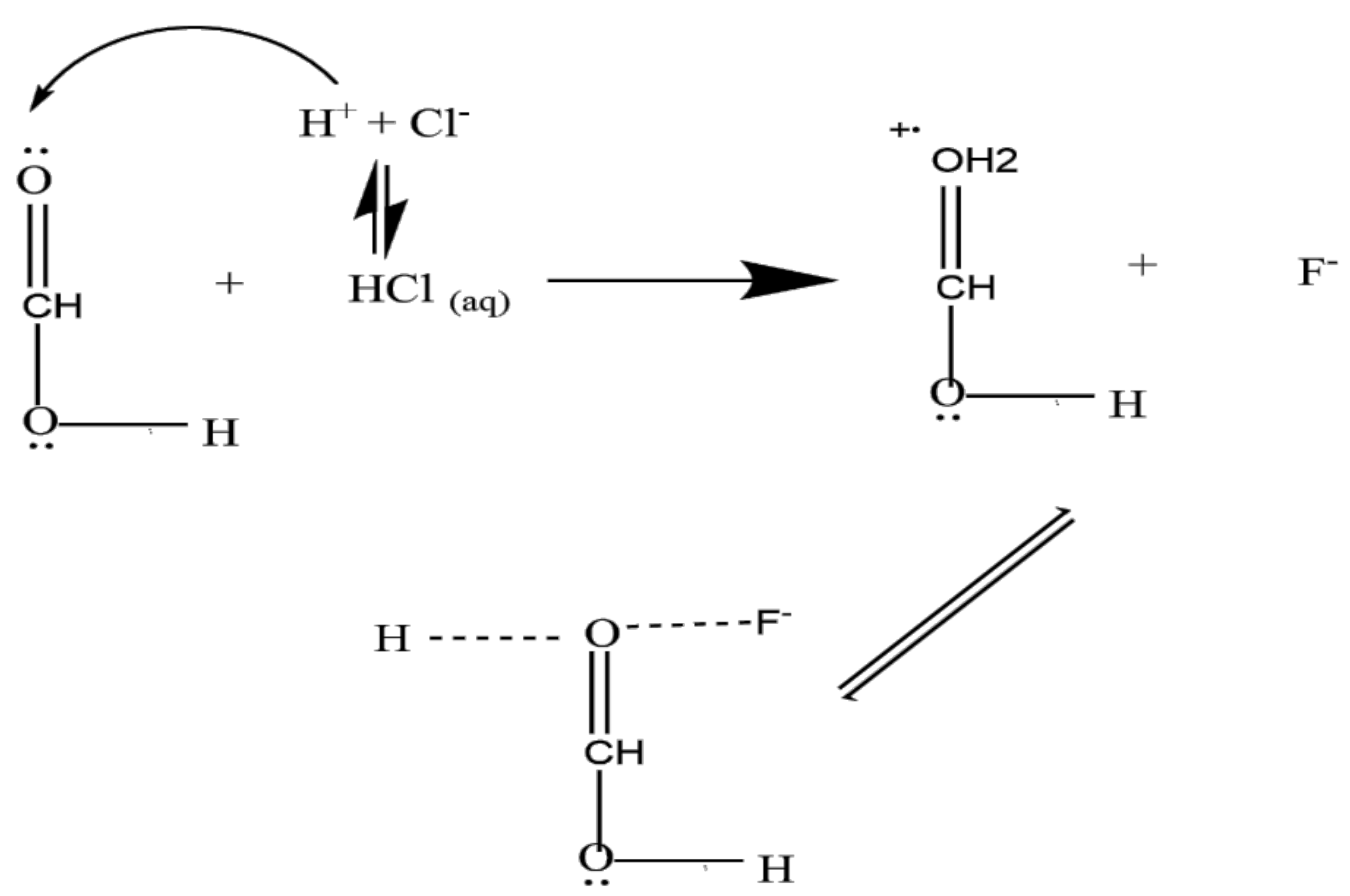
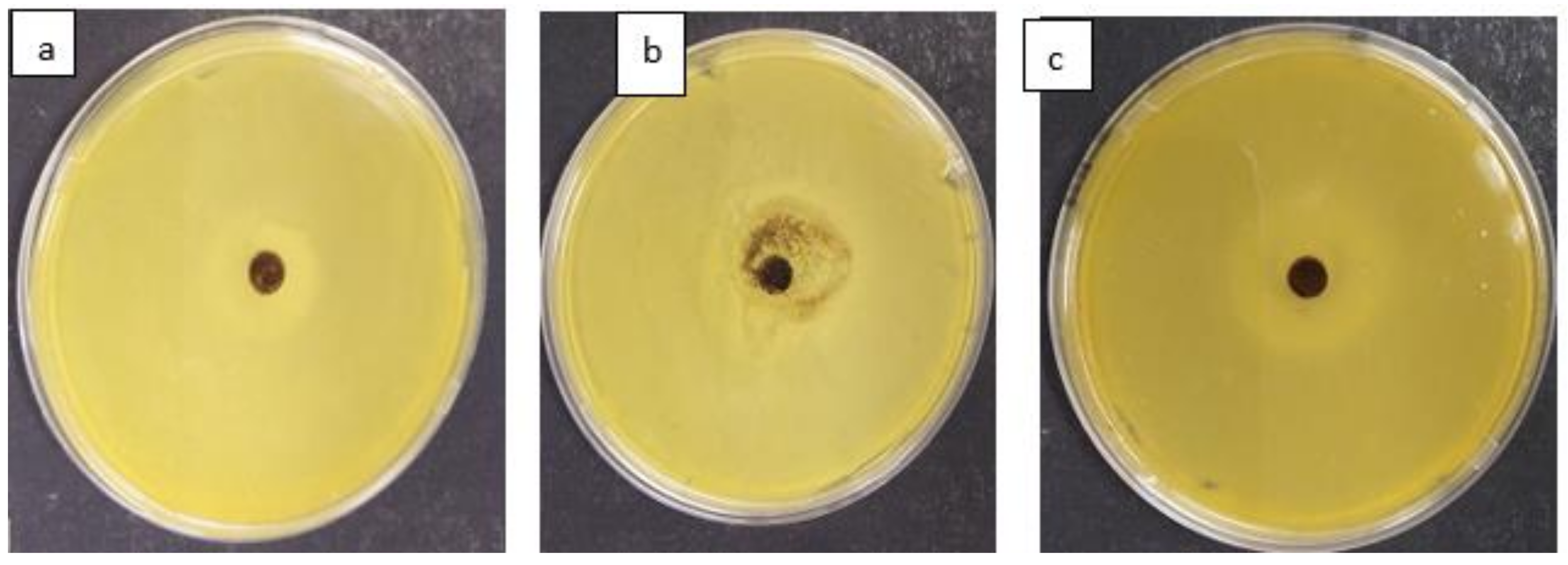
| Element/Oxide | Composition (%) |
|---|---|
| C | 49.56 |
| O | 44.08 |
| H | 6.20 |
| N | 0.20 |
| Surface Area (m2/g) | Pore Diameter (nm) | Pore Volume (cm3/g) |
|---|---|---|
| 1.69 | 15.4 | 0.01 |
| PFO | PSO | ||||||
|---|---|---|---|---|---|---|---|
| K1 (min−1) | qe (mg/g) | R2 | X2 | K2 (g/mg·min) | qe (mg/g) | R2 | X2 |
| 0.35 | 0.51 | 0.89 | 0.001412 | 1.26 | 0.53 | 0.95 | 0.000569 |
| Model | MNS | |
|---|---|---|
| Intra particle diffusion | K1 (mg/g min−1) | 0.08 |
| K2 (mg/g min−1) | 0.02 | |
| K3 (mg/g min−1) | 0.005 | |
| R2 (phase 1) | 1 | |
| R2 (phase 2) | 0.99 | |
| R2 (phase 3) | 1 |
| Langmuir Isotherm | Freundlich Isotherm | |||||||
|---|---|---|---|---|---|---|---|---|
| Temperature (K) | qm (mg/g) | KL (L/mg) | X2 | R2 | 1/n | Kf (mg/g/(mg/L)n) | R2 | X2 |
| 298 | 0.57 | 1.10 | 0.00188 | 0.99 | 0.08 | 0.43 | 0.86 | 0.01156 |
| 308 | 0.37 | 0.33 | 0.00294 | 0.99 | 0.15 | 0.22 | 0.99 | 0.00107 |
| 318 | 0.05 | 0.20 | 0.00269 | 0.98 | 0.21 | 0.14 | 0.96 | 0.01160 |
| Adsorbent | Adsorption Capacity (mg/g) | pH | Ref |
|---|---|---|---|
| Sugarcane bagasse | 1.2 | 5.4 | [33] |
| Coconut root | 1.75 | 7 | [34] |
| Sawdust raw | 1.73 | 6 | [35] |
| Wheat straw raw | 1.93 | 6 | [35] |
| Activated bagasse carbon | 1.15 | 6 | [35] |
| Senna auriculata L. flower petal biomas | 1.29 | 6–7 | [36] |
| Macadamia nut shells | 1.26 | 6 | This study |
| ∆G0 (kj/mol) | ∆H0 (kj/mol) | ∆Sᴼ (kj/mol) |
|---|---|---|
| 298 K = −30,393.6 308 K = −22,388 318 K = −21,791 | 158.93 | 435.32 |
Publisher’s Note: MDPI stays neutral with regard to jurisdictional claims in published maps and institutional affiliations. |
© 2022 by the authors. Licensee MDPI, Basel, Switzerland. This article is an open access article distributed under the terms and conditions of the Creative Commons Attribution (CC BY) license (https://creativecommons.org/licenses/by/4.0/).
Share and Cite
Nekhavhambe, H.H.; Mudzielwana, R.; Gitari, M.W.; Ayinde, W.B.; Izevbekhai, O.U. Fluoride Bio-Sorption Efficiency and Antimicrobial Potency of Macadamia Nut Shells. Materials 2022, 15, 1065. https://doi.org/10.3390/ma15031065
Nekhavhambe HH, Mudzielwana R, Gitari MW, Ayinde WB, Izevbekhai OU. Fluoride Bio-Sorption Efficiency and Antimicrobial Potency of Macadamia Nut Shells. Materials. 2022; 15(3):1065. https://doi.org/10.3390/ma15031065
Chicago/Turabian StyleNekhavhambe, Humbelani H., Rabelani Mudzielwana, Mugera W. Gitari, Wasiu B. Ayinde, and Oisaemi U. Izevbekhai. 2022. "Fluoride Bio-Sorption Efficiency and Antimicrobial Potency of Macadamia Nut Shells" Materials 15, no. 3: 1065. https://doi.org/10.3390/ma15031065
APA StyleNekhavhambe, H. H., Mudzielwana, R., Gitari, M. W., Ayinde, W. B., & Izevbekhai, O. U. (2022). Fluoride Bio-Sorption Efficiency and Antimicrobial Potency of Macadamia Nut Shells. Materials, 15(3), 1065. https://doi.org/10.3390/ma15031065






